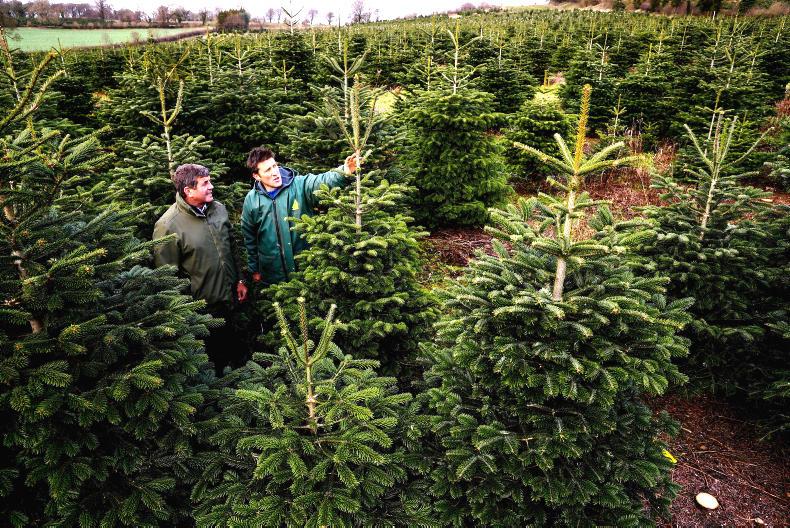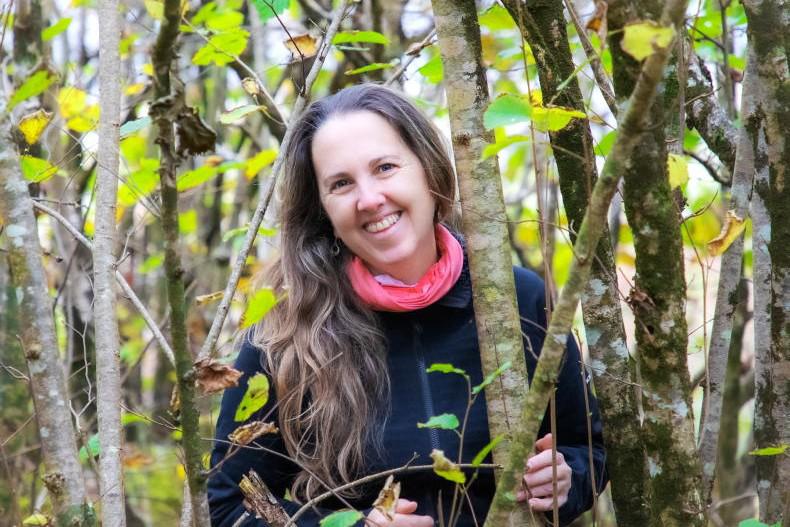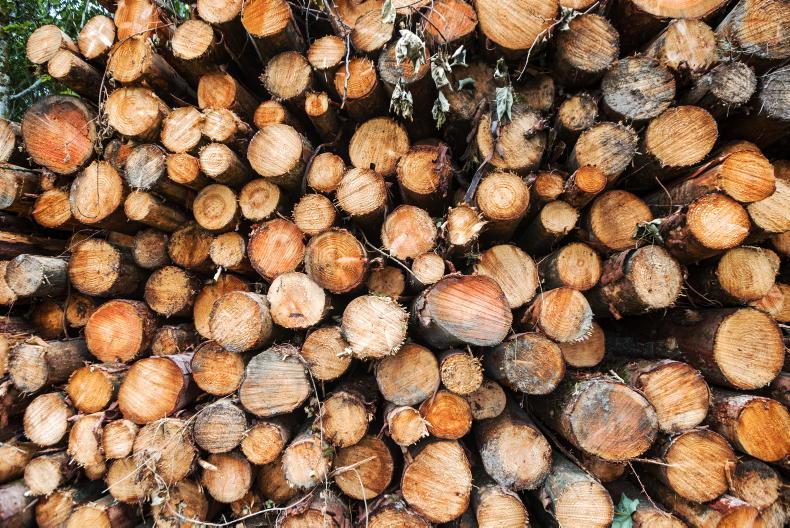The midterm review (MTR) introduced higher grant and premium rates “to encourage more broadleaf and diverse conifer planting”. A key aim of the MTR – and reiterated recently by Minister of State Andrew Doyle – is to achieve a 30% broadleaf planting programme.
We are fortunate in Ireland to have the climatic and soil conditions to grow a wide range of species. Table 1 illustrates the range of species currently growing in Irish forests identified in the National Forest Inventory (NFI) 2017.
Sitka spruce dominates the species composition list at 50.9%, which is down from 52.3% in 2007.
Sitka represents 44% of the forest estate, with the remainder represented by diverse conifers, broadleaves and open areas including roads, rivers, ditches, ridelines and riparian zones. It also features in Coillte’s 90,000ha, which has been designated by the company as biodiverse habitat.
Despite recent comments about Sitka dominating the landscape now or in the future, the fact is that it currently covers 4.7% of the land area of Ireland.
Based on species selection and planting programmes achieved over the past five years, Sitka will increase by a further 1.5% by 2050 and possibly less if the 30% broadleaf target is achieved along with increased planting of minor conifers.
As Sitka spruce is the main contributor to the Irish forestry and forest products industry with an annual output of €2.3bn, it is likely that it will remain a key species. While 50.9% of Ireland’s forest composition comprises Sitka spruce, it produces 59% of the growing stock.
Conversely, while broadleaves cover 29% of the estate, they contribute 19% to the growing stock, according to the NFI.
Most productive species
The MTR acknowledges the role of Sitka in the conifer mix: “Sitka has proven itself to be one of the most productive coniferous species grown in Ireland and as such has become the industry’s mainstay in terms of timber processing and end markets.”
However, it also stresses the need for species diversification. The potential for wide-scale species diversification is limited in Ireland, especially with native species.
Looking down through the list of species in Table 1, indigenous species such as ash and elm and non-native larch are no longer planted due to disease vulnerability.
However, Table 1 provides a list of alternative species, including three conifers – Douglas fir, Norway spruce and the native Scots pine – while western red cedar, western hemlock and Monterey pine also have potential.
The broadleaf species menu is restricted to sessile and pedunculate oak, birch and alder, along with introduced but naturalised sweet chestnut, sycamore and beech.
Target
So is the 30% broadleaf target achievable against this background? Foresters and forest owners acknowledge that a balanced mix of broadleaves and conifers has environmental and aesthetic benefits, but also poses challenges as forest owners are being asked to provide close to 30% of their forests with species that will not provide a viable income for generations to come.
However, the reaction from a number of forestry companies has been positive towards the minister’s commitment to achieve the 30% broadleaf target. They also point to Coillte, who they believe should also aim for a higher percentage of broadleaves in their reforestation programme.
The 30% broadleaf target for the private sector is achievable, according to Green Belt’s John O’Reilly, Veon Ltd’s Daragh Little, Paddy Bruton of Forestry Services and president of the Society of Irish Foresters Gerry Murphy.
Increase broadleaf plantings
They believe that the introduction of scenario five in the Native Woodland Scheme (NWS) framework would allow planting of some modified peat and peaty podzols, which they believe will help in not only achieving the 30% target for native broadleaves, but also help increase afforestation of Scots pine, Ireland’s only commercial native conifer.
While the premium payments are attractive for broadleaves, “the premium period –15 years – is a major inhibiting factor as it represents little more than 15% of the rotation length for species such as oak and beech,” according to Paddy Bruton. “This period has to be increased as does the grant covering deer fencing,” he said.
Regarding nursery supply, Teige Ryan of None so Hardy Nurseries maintained that the transition to increased broadleaved planting is already taking place, as “40% of all our species delivered since February have been broadleaves,” he said.
“Our Ballymurn nursery is currently stocked with approximately 15 million broadleaves, all destined for the Irish market over the next two to three years. Species include oak, birch, alder, rowan, hazel, beech, sycamore, whitethorn, blackthorn, cherry, willow and crab apple. All of these species are available from locally collected seeds or Irish provenances.”
He agrees with the views expressed by their customers that the Minister’s 30% broadleaf challenge is a demanding, but ultimately an achievable element of the forestry programme.
Rare species in Irish forests
The NFI identified more than 50 species (Table 1) but there may be as many more albeit in small numbers which would have escaped the comprehensive inventory which worked off a set of 1,923 permanent sample plots. Species that didn’t make the list include pine (Weymouth, maritime and Macedonian) and spruce (Serbian and Himalayan). Likewise, broadleaves that didn’t make the cut include hornbeam, poplar species (black, white and the native aspen), blackthorn and eucalyptus species other than E. gunnii.
The midterm review (MTR) introduced higher grant and premium rates “to encourage more broadleaf and diverse conifer planting”. A key aim of the MTR – and reiterated recently by Minister of State Andrew Doyle – is to achieve a 30% broadleaf planting programme.
We are fortunate in Ireland to have the climatic and soil conditions to grow a wide range of species. Table 1 illustrates the range of species currently growing in Irish forests identified in the National Forest Inventory (NFI) 2017.
Sitka spruce dominates the species composition list at 50.9%, which is down from 52.3% in 2007.
Sitka represents 44% of the forest estate, with the remainder represented by diverse conifers, broadleaves and open areas including roads, rivers, ditches, ridelines and riparian zones. It also features in Coillte’s 90,000ha, which has been designated by the company as biodiverse habitat.
Despite recent comments about Sitka dominating the landscape now or in the future, the fact is that it currently covers 4.7% of the land area of Ireland.
Based on species selection and planting programmes achieved over the past five years, Sitka will increase by a further 1.5% by 2050 and possibly less if the 30% broadleaf target is achieved along with increased planting of minor conifers.
As Sitka spruce is the main contributor to the Irish forestry and forest products industry with an annual output of €2.3bn, it is likely that it will remain a key species. While 50.9% of Ireland’s forest composition comprises Sitka spruce, it produces 59% of the growing stock.
Conversely, while broadleaves cover 29% of the estate, they contribute 19% to the growing stock, according to the NFI.
Most productive species
The MTR acknowledges the role of Sitka in the conifer mix: “Sitka has proven itself to be one of the most productive coniferous species grown in Ireland and as such has become the industry’s mainstay in terms of timber processing and end markets.”
However, it also stresses the need for species diversification. The potential for wide-scale species diversification is limited in Ireland, especially with native species.
Looking down through the list of species in Table 1, indigenous species such as ash and elm and non-native larch are no longer planted due to disease vulnerability.
However, Table 1 provides a list of alternative species, including three conifers – Douglas fir, Norway spruce and the native Scots pine – while western red cedar, western hemlock and Monterey pine also have potential.
The broadleaf species menu is restricted to sessile and pedunculate oak, birch and alder, along with introduced but naturalised sweet chestnut, sycamore and beech.
Target
So is the 30% broadleaf target achievable against this background? Foresters and forest owners acknowledge that a balanced mix of broadleaves and conifers has environmental and aesthetic benefits, but also poses challenges as forest owners are being asked to provide close to 30% of their forests with species that will not provide a viable income for generations to come.
However, the reaction from a number of forestry companies has been positive towards the minister’s commitment to achieve the 30% broadleaf target. They also point to Coillte, who they believe should also aim for a higher percentage of broadleaves in their reforestation programme.
The 30% broadleaf target for the private sector is achievable, according to Green Belt’s John O’Reilly, Veon Ltd’s Daragh Little, Paddy Bruton of Forestry Services and president of the Society of Irish Foresters Gerry Murphy.
Increase broadleaf plantings
They believe that the introduction of scenario five in the Native Woodland Scheme (NWS) framework would allow planting of some modified peat and peaty podzols, which they believe will help in not only achieving the 30% target for native broadleaves, but also help increase afforestation of Scots pine, Ireland’s only commercial native conifer.
While the premium payments are attractive for broadleaves, “the premium period –15 years – is a major inhibiting factor as it represents little more than 15% of the rotation length for species such as oak and beech,” according to Paddy Bruton. “This period has to be increased as does the grant covering deer fencing,” he said.
Regarding nursery supply, Teige Ryan of None so Hardy Nurseries maintained that the transition to increased broadleaved planting is already taking place, as “40% of all our species delivered since February have been broadleaves,” he said.
“Our Ballymurn nursery is currently stocked with approximately 15 million broadleaves, all destined for the Irish market over the next two to three years. Species include oak, birch, alder, rowan, hazel, beech, sycamore, whitethorn, blackthorn, cherry, willow and crab apple. All of these species are available from locally collected seeds or Irish provenances.”
He agrees with the views expressed by their customers that the Minister’s 30% broadleaf challenge is a demanding, but ultimately an achievable element of the forestry programme.
Rare species in Irish forests
The NFI identified more than 50 species (Table 1) but there may be as many more albeit in small numbers which would have escaped the comprehensive inventory which worked off a set of 1,923 permanent sample plots. Species that didn’t make the list include pine (Weymouth, maritime and Macedonian) and spruce (Serbian and Himalayan). Likewise, broadleaves that didn’t make the cut include hornbeam, poplar species (black, white and the native aspen), blackthorn and eucalyptus species other than E. gunnii.










SHARING OPTIONS